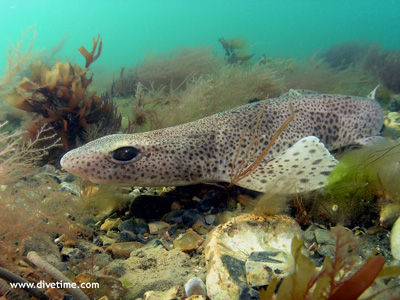Generalities
The small dogfish, Scyliorhinus canicula (S. canicula), is a small shark abundant in the Mediterranean Sea and the North and East Atlantic. The dogfish can be maintained in a laboratory with adequate infrastructure, available at several marine stations in Europe. Dogfish is a very suitable candidate species to become the reference model for the chondrichthyes (cartilaginous fish) group, the brother group of the osteichtyes (bony fish). It has all the major morphological characteristics of gnathostomata (paired limbs, true teeth, scapular and pelvic girdle…). It also has complex physiological characteristics and sensory organs. Its study is of major interest for the understanding of the origin and diversification of gnathostomata, and more generally in any systematic comparative approach on the scale of gnathostomata.
More specifically, it is a key species for the identification of derived traits specific to the two subgroups of osteichtyes: actinopterygii and sarcopterygii. The possibilities of obtaining embryos, the availability of established functional approaches (in ovo pharmacological treatments) and ongoing developments (embryo culture, electroporation, applications of impregnated beads) currently make it an essential model organism for chondrichthyes.
- Name : Scyliorhinus canicula
- Chordate, Vertebrate, Chondrichthyes, Galeomorphii, family of Carcharhiniformes
- Genome sequencing is currently the subject of several applications submitted or in preparation (ANR, Genoscope; contact: Sylvie Mazan).
-
Size of the genome : 3.34 billion pb (estimates by: D. Chassoux and S. Mazan).
Putative gene number unknown. However, available data show:
(1) that the two sets of polyploidization that originally occured in vertebrates occured prior to the radiation of gnathostomata ;
(2) that no indication of additional polyploidization (such as that occurring in actinopterygii) has been obtained. These characteristics make the dogfish an ideal external group for reconstructing the ancestral genome of gnathostomata and identifying gene losses and gains in large groups of osteichtyes.
Reproduction
Internal fertilization, oviparous.
No significant seasonality, but the frequency of spawning peaks between March and June. Spawning is low: 2 eggs per female every 2 to 3 weeks at the peak of spawning.
The life cycle is long, with females reaching sexual maturity at the age of 6 to 8 years. The obtaining of embryos therefore currently relies solely on the use of breeding stock from wild populations held in captivity.
Tools
- BAC and EST librairies
- Possible molecular and functional approaches: in situ hybridization, immunohistochemistry
- Pharmacological treatments in ovo
Databases
Internal EST collection, database of 250.000 embryonic EST,
collection of corresponding clones, available on request from S. Mazan.
BAC librairies, 200.000 clones, average size of inserted fragment of 150 kb.
Development table: the most commonly used is Ballard and al. 1993. J. Exp. Zoology 267 :318-336.
Infrastructures
- Service Mer et Observation de la Station Biologique de Roscoff - Laurent Lévèque
- Roscoff
- Equipe Développement et évolution des vertébrés UMR 7150-CNRS-UPMC - Sylvie Mazan
- Roscoff
Experts
- Laurent LEVEQUE
- modeles.biologiques@sb-roscoff.fr
- Station Biologique de Roscoff, Service Mer et Observation
Bibliography
- Articles
« Towards a synthetic view of axis specification mechanisms in vertebrates: insights from the dogfish. », Coolen M., Menuet A., Mazan S., C R Biol., 2009
« Evolution of genetic networks underlying the emergence of thymopoiesis in vertebrates. », Bajoghli B. et al., Cell, 2009
« The dogfish Scyliorhinus canicula, a reference in jawed vertebrates. », Coolen, M., Cold Spring Harbor Press Chapter 21 pp 431-446., 2008
« A molecular analysis of neurogenic placode and cranial sensory ganglion development in the shark, Scyliorhinus canicula. », Guérin A. et al., PLoS One., 2009
« Cyclostome studies in the context of vertebrate evolution. », O’Neill P., McCole RB., Baker CV., Dev Biol., 2007
« Biphasic Hoxd gene expression in shark paired fins reveals an ancient origin of the distal limb domain. », Freitas R., Zhang G., Cohn MJ., PLoS One., 2007
« Evidence that mechanisms of fin development evolved in the midline of early vertebrates. », Freitas R., Zhang G., Cohn MJ., Nature, 2006
